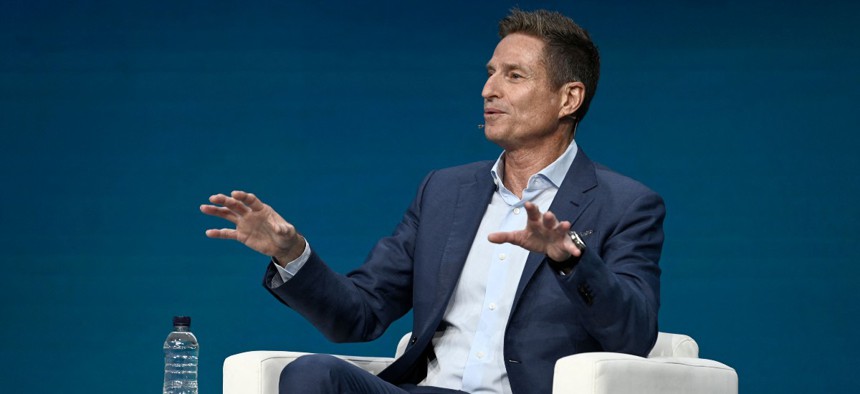Lockheed further details 'Evolve' partnership approach and new lunar business

Lockheed Martin's chairman and CEO Jaimes Taiclet speaks at the Mobile World Congress in Barcelona on Feb. 28. Photo by Josep Lago / AFP via Getty Images.
Companies "outside of our normal sphere" are where Lockheed Martin chief executive Jim Taiclet wants the defense giant to go looking for teammates.
One of Lockheed Martin's main pathways for reaching into the broader defense and technology ecosystems goes through its venture capital investment organization for financially backing and working with startups.
A second pathway is how Lockheed works with its defense hardware manufacturing peers to build large, complex systems for the U.S. government. Northrop Grumman makes the center fuselage for the F-35 fighter jet for instance, while BAE Systems Inc. makes the rear fuselage.
But during Lockheed's first quarter earnings call Tuesday, chief executive Jim Taiclet brought up to investors a point he likely has made across the company itself over recent months:
"What we needed in the middle was something to work with midsized companies and in the technology sector to work with us in ways that really don't have a traditional history with companies like Lockheed Martin and our peer group," Taiclet said.
Taiclet first previewed how Lockheed would go about doing that in the fall when he announced LM Evolve -- an internal division responsible for creating partnerships with those midsized companies in the defense, space and commercial tech verticals.
Some potential options for those partnerships can include joint ventures, co-investments and other types of commercial arrangements.
LM Evolve's sights may appear at first glance to be on the middle tier, they are not exclusive to companies in that size range. Taiclet said the team can also work with other large companies "outside of our normal sphere" to develop new capabilities for national defense and space exploration.
"We have to work at Lockheed Martin with a wider variety of companies from the tech sector to laser-guided weapons, supply chain companies that we may not be doing current business with, and they can be start-ups to Microsoft size corporation," Taiclet said.
Perhaps unsurprisingly, space is where Taiclet's vision for those overall different approaches to partnering and investing will be on full display through Lockheed's newly stood-up commercial subsidiary called Crescent Space Services.
Unveiled to the world in late March, Crescent's gameplan is to field a constellation of satellites orbiting around the Moon to support other spacecraft there or on the surface. Crescent will own and operate the satellites, for which it is eyeing the first batch to launch in 2025.
Those satellites will support communications and transportation on the Moon's surface, where both humans and robotic systems would operate. As Taiclet told the Mobile World Congress in March: establishing all of that on the Moon is necessary to land on Mars.
In order to do that at a more commercial-like cadence, Crescent will have a different approach to capital investment than the other Lockheed business areas that are more tied to traditional government contracting policies and procedures.
Taiclet said Lockheed and Crescent will employ more creative capital sourcing methods to build up that business, or in other words not those that "come out of the disclosure statement that goes back to the (Defense Department) or NASA into our rates.
"It's going to be independently sourced. Our partners may contribute directly, but they will be outside the rate structure and the federal acquisition regulations, so that we can get the full benefit of those investments over time and also create more creatively finance them and partner with others to do that."
First quarter revenue totaled $15.1 billion compared to $15 billion in the prior year period, while profit of $1.7 billion was also relatively flat.
Lockheed reiterated its 2023 outlook of $65 billion-to-$66 billion in revenue on $7.255 billion-to-$7.355 billion in segment operating profit.
NEXT STORY: Renovus unveils new government services company


